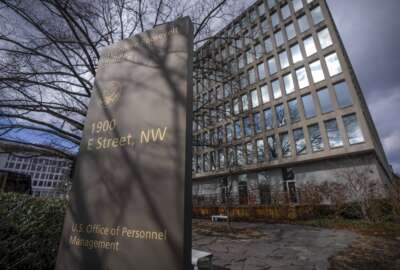GSA offered contractors tax breaks – at a price
A new General Services Administration policy is once again drawing fire. The focus now is on a GSA policy in which the agency offered tax breaks to companies to...
By ALAN FRAM
Associated Press
WASHINGTON (AP) – It was a curious offer to contractors from a government agency: We’ll give you a tax deduction for making federal buildings more energy efficient if you qualify and if you’ll write us a check for 19 percent of the tax break’s value.
The General Services Administration, already under a cloud for a lavish Las Vegas employee conference, says that after seven months, it dropped its demand for the giveback requirement because there were no takers.
But the policy is now raising new questions about whether GSA was trying to raise money for its own budget without congressional authorization, whether that effort was legal and whether other agencies have tried anything similar.
“It was brought to our attention that certain people at agencies were asking for what looked like kickbacks in order to get allocations of a tax deduction,” Rep. Charles Boustany, R-La., chairman of the House Ways and Means Committee’s oversight panel, said Thursday. “This is a major concern and I’m certainly going to investigate this.”
GSA officials said the practice was legal and a way for them to raise money to make additional federal buildings more energy efficient. GSA manages 9,600 federally owned or leased buildings, more than any other landlord, though some federal properties are owned by the Defense Department or other agencies.
Boustany sent letters Thursday to 17 agencies and Cabinet-level departments, including GSA, seeking details and asking whether others have engaged in similar practices.
Letters GSA sent to contractors last year said that if they met all the conditions for the tax break, the agency would be willing to grant the deduction “upon payment to GSA of 19 percent of the deduction amount.” The money was to be used by GSA “to invest in additional energy-efficiency projects,” said the letter, signed by Patrick J. Fee, director of GSA’s building operations division.
A letter of intent attached to Fee’s letter added more detail.
“The contractor shall send a check made out to `General Services Administration’ in the amount of 19 percent of the amount of the deduction allocated, with the notation, `179D Deduction Payment,”‘ it said.
The tax break is called a 179D deduction after the section of the tax code that established it. It’s intended for owners of buildings that install lighting, cooling, heating or other energy systems that cut power costs in half, compared to comparable buildings. If the federal, state or local government owns the building, they are allowed to pass the tax deduction to the person it considers most responsible for designing the energy savings.
The deduction, included in energy legislation first enacted in 2005 under President George W. Bush, was extended in 2008 through next year. It is estimated it would cost the government roughly $1.6 billion to renew it for the following decade.
GSA spokesman Adam Elkington said the agency believes its attempt to require refunds from contractors was legal, citing a separate law that lets officials put money “from rebates or other cash incentives related to energy savings” into a fund the government uses to manage its buildings.
While acknowledging that the law did not specifically empower agencies to seek refunds of money from the energy tax deduction, he said that when it comes to granting that deduction to contractors, “The IRS has not placed limitations on the manner, terms or conditions by which an agency may make such a decision.”
Several longtime tax analysts said it is not unusual for state and local governments to use potential tax deductions as bargaining chips with private contractors, getting them to provide lower prices or extra services in exchange for the tax break. But they could not recall instances in which federal agencies demanded partial paybacks for tax breaks they distribute.
“An agency, in effect, asking for a rebate? That’s stunning to me. I’ve never heard of it before,” said Edward Kleinbard, a tax law professor at the University of Southern California law school, who once headed Congress’ nonpartisan Joint Committee on Taxation. The joing committee analyzes tax issues for lawmakers.
GSA’s Elkington said the policy was in effect from May 18 until Dec. 23 last year.
“It was an attempt to increase the ability of the federal government to provide additional energy efficiency upgrades for our own federal buildings,” he said.
The policy was dropped, he said, because “basically, no one had taken part in it. It was just determined it wasn’t economically viable for designers” of energy systems because the 19 percent giveback was eroding their profits.
Since the tax break’s inception, GSA has granted it for 15 projects by seven different contractors, and has one application pending, Elkington said. None involved the 19 percent giveback.
The American Institute of Architects, whose members are among the beneficiaries of the tax break, said it warned GSA officials that firms would not participate in the program if they had to return 19 percent of the money. On its website, the institute takes credit for talking GSA into abandoning the idea.
“As we said, `19 percent of zero is zero,”‘ said institute lobbyist Andrew Goldberg. “If you’re going to do it, you’re not going to get any money back.”
The institute’s lawyers believed GSA’s policy of seeking a 19 percent giveback was legal, Goldberg said.
The law specifies that owners of buildings that meet specified energy efficiency standards can qualify for tax deductions worth up to the value of the equipment and material they install or up to $1.80 a square foot, whichever is less.
RELATED STORIES:
Causey: Feds feel sting of GSA, Secret Service scandals
GSA, Energy going alternative to run its buildings
Copyright © 2024 Federal News Network. All rights reserved. This website is not intended for users located within the European Economic Area.





